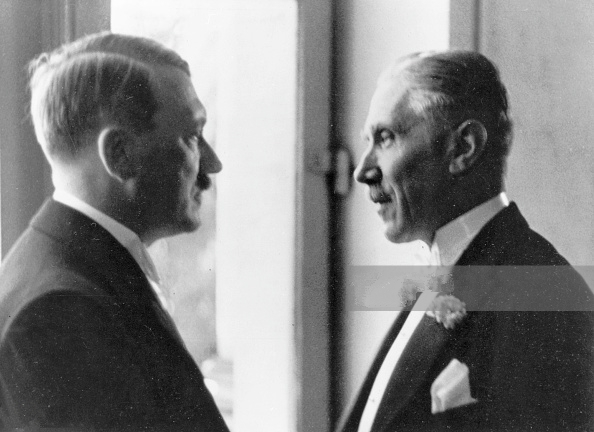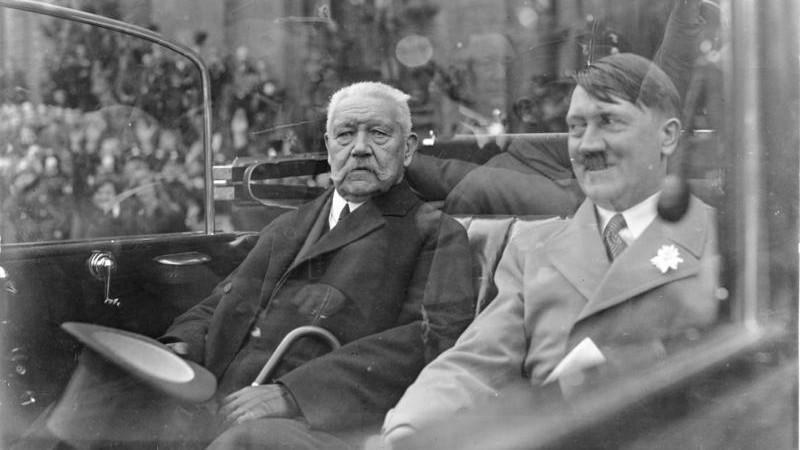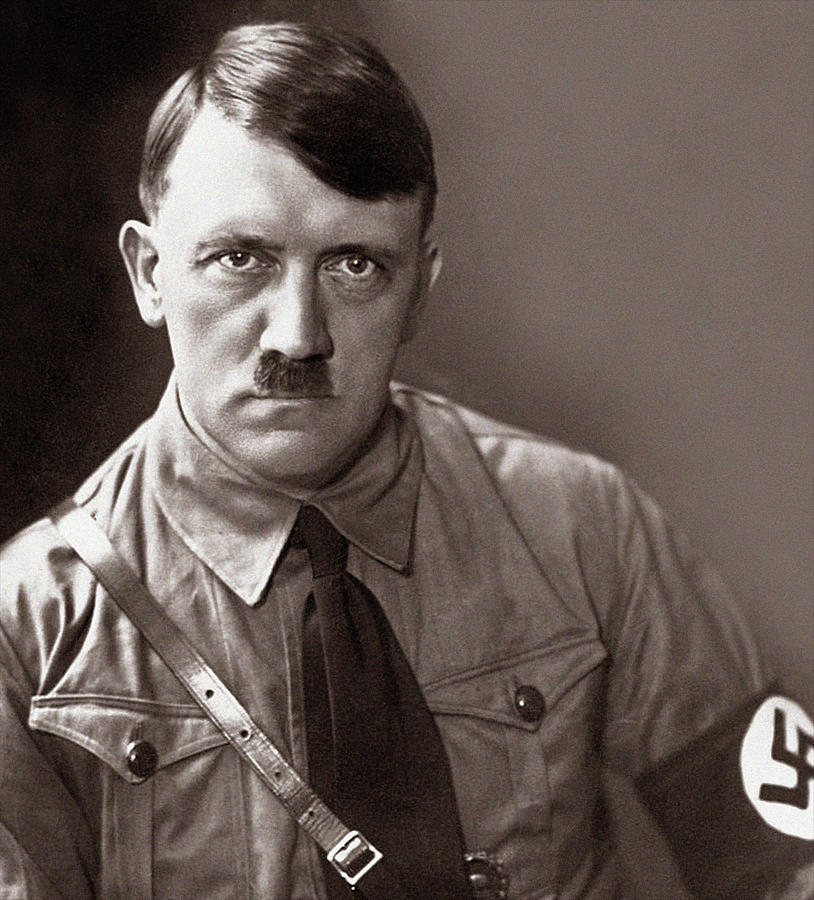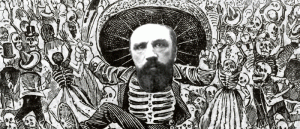The year is 1932. The place, Berlin, Germany. The date, November 6. On this day, the fourth and final election of the year took place for seats in the Reichstag, which was the legislative body of the Weimar Republic. All the major political parties in Germany were vying for seats in the legislature. Although this was the fourth election of the year, it was arguably the most important, and even more important than the recent presidential election had been. The Nationalsozialistische Deutsche Arbeiterpartei (NSDAP), or the National Socialist German Workers Party in English, otherwise known as the Nazi Party, had been controlling seats in the Reichstag since the July election. Led by Adolf Hitler, the NSDAP had become one of the most popular parties in the Weimar Republic up to that November election. The seats in the Reichstag would be filled by five main political parties in Germany: The NSDAP, Deutschnationale Volkspartei (DNVP), or German National People’s Party, Kommunistische Partei Deutschlands (KPD), otherwise known as the Communist Party of Germany in English, Sozialdemokratische Partei Deutschland (SPD), or Social Democratic Party in English, and the Zentrumspartei, otherwise known as the Catholic Centre Party.1
In this November election, the NSDAP lost 34 seats compared to its July election results, while the DNVP and the KPD gained seats back. This was pivotal for the future of Germany, and especially for the President Paul von Hindenburg. Being a conservative independent, he found it ever increasingly difficult to lead the Weimar Republic. Hindenburg had become very worried about the rise of the NSDAP. He was concerned mainly with their leader, Adolf Hitler, who showed signs of extremist ideologies. After the July Reichstag elections, the Nazis had become the largest party in the Reichstag. It was assumed that the leader of Germany’s largest party, Adolf Hitler, would be appointed Chancellor of the Republic. But Hindenburg distrusted and disliked Hitler and refused to appoint him. Thus, this November election reassured Hindenburg and the rest of the Weimar Republic, that the Nazi Party had peaked and was now on the decline. Even the Nazi party leadership thought so. But the current Chancellor, Franz von Papen, found it almost impossible to govern. He could form no coalition government in the Reichstag, and had lost the confidence of his cabinet.2
At this time in 1932, Germany was in the depths of the Depression. By the end of November, the economic depression was at its all-time worst. Unemployment was in the 30% range. President Hindenburg was having trouble controlling the economic nosedive and its accompanying political chaos. So, despite the results of the recent election, the Nazis road a wave of popularity. Hitler used the hardships of the depression as a way to appeal to the middle and lower-middle classes. He employed propaganda to take advantage of the vulnerability of these German citizens. Many had lost faith in democracy and were open to more extreme parties, especially the NSDAP and the KPD. Nevertheless, by the end of November, the Nazis had peaked, and yet the Depression raged on, and the German government was adrift.3
On December 1, President Hindenburg met with the former Chancellor of the Weimar Republic, Franz von Papen, and the Minister of Defense, Kurt von Schleicher. Hindenburg had exhausted all options in trying to curb unemployment and was open to any and all ideas that would reduce the effects of the Depression. Franz von Papen had been Chancellor before the November elections, and Hindenburg had to appoint someone now to try to form a new government. He wanted to reappoint Papen, but Papen was unable to form a coalition government in the Reichstag, which meant that he would have to rule, not through normal parliamentary governing through the Reichstag, but through Hindenburg’s presidential emergency decrees according to Article 48 of the Weimar constitution. This would be called a “Presidential Cabinet,” which would be a legal option for governing, but not the most desirable. Papen then suggested at this meeting that Hindenburg reappoint him as Chancellor and his former cabinet. The Reichstag would certainly not support him or his cabinet, and he would then have to suspend the Reichstag for a while, which would be unconstitutional, but necessary. In effect, he suggested a revolution. He suggested a whole new style of government: an authoritarian government where there would be no political parties and no trade unions. This type of government would be backed by military and police rule, “for a short time.” In other words, he was proposing the overthrow of the Weimar Republic in favor of a military dictatorship, in the guise of dealing with a state of emergency. The one thing holding Papen back from following through with his plan was that he would need the help of the Reichswehr (the German military) to back him up in these efforts. To do this, he would need the cooperation of Kurt von Schleicher who, as the recently appointed Minister of Defense, was in charge of the Reichswehr. But Schleicher didn’t believe that Papen’s plans would work. He flatly stated that the Reichswehr was simply not up to job. And it could not be relied on to take action against the Nazi paramilitary forces, or the SA Brownshirts. This matter was important to Schleicher because he could not bear to see a political civil war take place in which the Reichswehr would be pitted against both the Nazis and the Communists. To Schleicher, the only real salvation for the Republic would come if he himself were to be appointed chancellor. Hindenburg decided to give Papen a chance, and reappointed him Chancellor. When Hindenburg left the meeting, Papen and Schleicher engaged in extremely heated exchanges.4
The next day, on December 2, President Hindenburg’s cabinet reconvened. They picked right back up where they left off the previous day. Schleicher told Chancellor Papen once more that if he tried to form the authoritarian-style government he wanted, it would cause extreme political divide and bring the country into chaos. He also said that the Reichswehr would not support action against the Nazi SA. Hindenburg, the war hero of World War I, felt betrayed at hearing that his army would rather support Hitler than himself. But nevertheless, he saw no other way than to follow Schleicher’s way of thinking. Ultimately, Hindenburg made the difficult decision to withdraw Papen as chancellor. Later that day, President Hindenburg appointed Kurt von Schleicher to be the next chancellor of the Weimar Republic.5
One may ask, what gave Hindenburg the right to appoint the chancellor of the Weimar Republic? How did he have this power? After World War I, when the Weimar Republic was established, the main goal of the political parties in charge was to rule as a democracy. They created a constitution to clearly define laws that would govern their democracy. During this process, the designers of the Weimar constitution wanted to implement a system of checks and balances that would reduce the possibility of a rebellion or coup. Six articles were created with this end in mind.6 The articles that were used the most for that purpose were Articles 48 and 53. Article 48 allowed the President to rule by emergency decree when emergencies arose. President Hindenburg enacted this article on numerous occasions.7 It was one of the only ways to get laws passed if the Reichstag became dysfunctional, as it was for most of 1932. Article 53 allowed for the president to appoint and dismiss the chancellor. This law, too, gives the president complete authority over the Reichstag, undermining the democratic process. This is how President Hindenburg was able to appoint first Papen, and then Schleicher, and eventually also Hitler, to the position of chancellor. Articles 48 and 53 is what ultimately led the Weimar Republic to become more of an authoritative government during the final years of its existence.8
Kurt von Schleicher, as the new chancellor of the Weimar Republic, did not waste any time in trying to get things done. He immediately went to destroy the Nazis. His first way of doing this was to meet with Nazi leader Gregor Strasser. During this meeting, Schleicher offered Strasser the Vice-Chancellorship in hopes of making Hitler envious, attempting to pit the Nazi leaders against each other. Trying to play both sides for his own personal gain, former Chancellor Papen informed Hitler about the meeting between Schleicher and Strasser. Hitler then called a meeting with Strasser where he confronted him about his meeting with Schleicher. Strasser told Hitler that he supported Schleicher. The two got into a shouting match. Strasser accused Hitler of ruining the Nazi Party. Hitler accused Strasser of stabbing him in the back. On December 8, Strasser resigned from his position in the Nazi Party, leaving Hitler and the rest of the Nazi Party stunned. Gregor Strasser had been a founding member of the party. The Nazi party began to unravel, and Hitler went into a deep state of depression.9
During this time, Schleicher was trying to push new laws through the Reichstag; however, this did not end in his favor, as none of his proposals were passed. The fact that the Reichstag had become again dysfunctional worried the Nazis. They feared that Schleicher would dismiss the Reichstag and call for new elections, to elect members that were more sympathetic to his agenda. The Nazis knew that new elections would destroy them because they had lost all their momentum.10
In January of the next year, Chancellor Schleicher had a change of heart. He began to support Papen’s earlier plan of an authoritarian government. After Papen was relieved of his chancellorship duties, he remained close with President Hindenburg. Because of this, Hindenburg still took his advice very seriously. Papen was still trying to convince the President that an authoritarian government would be beneficial, but Hindenburg did not give in. Not getting the support he sought from President Hindenburg, Papen turned to Hitler. He hoped that an authoritarian government could be achieved if Hitler was in power. He believed he could manipulate Hitler into doing things that would benefit his own personal gain. Papen began to meet with Hitler to start discussing possible government arrangements, should Hitler be appointed Chancellor.11

On January 22, 1933, there was a secret meeting in the home of Jochim von Ribbentrop, a Nazi diplomat. The meeting consisted of Hitler, Papen, Oskar von Hindenburg (son of President Paul von Hindenburg), and Hermann Goering (another figure in the Nazi party). Hitler talked to Oskar von Hindenburg about the potential of himself being appointed Chancellor of the Weimar Republic. It was during this meeting that Papen openly pledged his loyalty to Hitler.12
While this is all happening, Schleicher went to Hindenburg and asked him to declare a state of emergency against the Nazis. Schleicher wanted to suspend elections and dissolve the Reichstag. He was trying to do anything he could to stop the Nazis’ late surge of momentum. But Hindenburg denied Schleicher’s request. Everyone started to lose faith in Schleicher as the Chancellor. No one would trust him. He contradicted everything he said and every action he tried to make. The date was January 28, 1933. Schleicher again went to Hindenburg, pleading with him to dissolve the Reichstag and let him rule by emergency decree without calling for new elections. Hindenburg was faced with a difficult choice. He could either support Schleicher’s idea of military rule, which was illegal and unconstitutional, or he could go the legal route and appoint a new chancellor. Hindenburg, however, didn’t want to be known as the President who destroyed the Weimar Republic, so he denied Schleicher’s request again. Soon after the meeting, Schleicher resigned his position as Chancellor of the Weimar Republic. Now that Schleicher was out of office, Papen whispered in Hindenburg’s ear who he thought should be the next chancellor. The name that Papen kept pushing for was Adolf Hitler.13
Adolf Hitler was born in a town in Austria called Braunau am Inn in 1889. He was born to a lower-middle class household. Hitler’s childhood was very uneventful. In 1913, Hitler fled to Munich in hopes of escaping service in the Austrian army. A year later, he coincidentally volunteered for the German army in World War I. While in the army, he was recognized several times for his bravery among other things. Once back in Munich working after the war, he came into contact with a few members of the German Workers Party, which would soon be known as the Nazi Party.14 Hitler made his name known in the party throughout the years. His radical ideology made him appeal to a much broader audience rather than a specific group of people. By 1930, he had support from the Protestants, mainly from rural regions and small towns, and from people who grew up in middle-class households. He also attracted the support from women young and old, because they had more opportunities with the Nazi party than with the KPD. Hitler did not really appeal to the working class, to the unemployed, to those in large urban centers like Berlin, or to Catholics. In each group, there were a few people that did support the party, but it was very underrepresented in the votes.15 Hitler became the face of the NSDAP, and his popularity grew to an all time high in July of 1932. Part of this was him getting people to believe in the Nazi ideology.16 The other part was that Germany was in complete economic and political turmoil, and the Nazi party was the party that seemed to show a dynamism lacking in the other parties. But still, one may ask, Why Hitler? Hitler had no political experience and had no previous education. Papen thought that this was perfect for him. He believed, if he could get Hitler to become Chancellor, he would still be able to control him and manipulate him. In Papen’s words, “he would be a Chancellor in chains.” Papen couldn’t have been more wrong.

On January 30, 1933, Hindenburg called Adolf Hitler for a meeting. Hindenburg then appointed Hitler as the new Chancellor of Germany. From this moment on, the course of history would never be the same. Hitler’s rise to power was an unusual one that started with him being a nobody from Austria, but it led to him becoming one of the most feared and notorious figures in world history.17
- Andreas Dorpalen, Hindenberg and the Weimar Republic (Princeton University Press, 1964), 371, https://www.jstor.org/stable/j.ctt183pm5s. ↵
- Andreas Dorpalen, Hindenberg and the Weimar Republic (Princeton University Press, 1964), 372-373, https://www.jstor.org/stable/j.ctt183pm5s. ↵
- Ruth Henig, The Weimar Republic 1919-1933 (London: Taylor & Francis Group, 1998), 72-73. ↵
- Andreas Dorpalen, Hindenberg and the Weimar Republic (Princeton University Press, 1964), 389-393, https://www.jstor.org/stable/j.ctt183pm5s. ↵
- Andreas Dorpalen, Hindenberg and the Weimar Republic (Princeton University Press, 1964), 394-397, https://www.jstor.org/stable/j.ctt183pm5s. ↵
- Anthony McElligott, Rethinking the Weimar Republic: Authority and Authoritarianism, 1916-1936 (A&C Black, 2013): 183. The articles were 25, 35ii, 41i, 48ii, 53, and 54. ↵
- Marc de Wilde, “The State of Emergency in the Weimer Republic Legal Disputes over Article 48 of the Weimar Constitution,” Tijdschrift Voor Rechtsgeschiedenis/Legal History Review 78, no. 1 and 2 (January 1, 2010): 137-140. ↵
- John P. McCormick, “The Crisis of Constitutional-Social Democracy in the Weimar Republic,” European Journal of Political Theory 1, no. 1 (July 1, 2002): 126–128, https://doi.org/10.1177/1474885102001001009. ↵
- Andreas Dorpalen, Hindenberg and the Weimar Republic (Princeton University Press, 1964), 399-400, https://www.jstor.org/stable/j.ctt183pm5s. ↵
- Andreas Dorpalen, Hindenberg and the Weimar Republic (Princeton University Press, 1964), 401-409, https://www.jstor.org/stable/j.ctt183pm5s. ↵
- Andreas Dorpalen, Hindenberg and the Weimar Republic (Princeton University Press, 1964), 410-416, https://www.jstor.org/stable/j.ctt183pm5s. ↵
- Andreas Dorpalen, Hindenberg and the Weimar Republic (Princeton University Press, 1964), 421-424, https://www.jstor.org/stable/j.ctt183pm5s. ↵
- Sidney B. Fay, “Hitler—Chancellor of Germany,” Current History (1916-1940) 37, no. 6 (1933): 742. ↵
- Ian Kershaw, Hitler (London, United Kingdom: Taylor & Francis Group, 2000), 1-2. ↵
- Brian Ault and William Brustein, “Joining the Nazi Party: Explaining the Political Geography of NSDAP Membership, 1925-1933,” American Behavioral Scientist 41, no. 9 (June 1, 1998): 1304-1308, 1319-1320, https://doi.org/10.1177/0002764298041009008. ↵
- Barbara Miller Lane and Leila J. Rupp, Nazi Ideology Before 1933: A Documentation (Manchester University Press, 1978), x-xxiii. ↵
- Andreas Dorpalen, Hindenberg and the Weimar Republic (Princeton University Press, 1964), 440-446, https://www.jstor.org/stable/j.ctt183pm5s. ↵



32 comments
Kristen Leary
Congratulations on your nomination for your article! It certainly took a lot of hard work and research to put it together, and it shows through your writing. It is a very interesting topic as well. Everyone knows about Hitler and what he did during World War II, but it isn’t often talked about what happened leading to him coming to power.
Luke Rodriguez
This was a fantastic read! Also, congrats on the nomination! It was well-deserved. The article was well-written and detailed. This was a well-structured article, and I truly enjoyed reading this. I found it interesting that we saw how complicated Hitler was and how he gained this power. And I also learned that Hittller grew his Nazi party as time passed and decided to run for office.
Luke Rodriguez
This was a fantastic read! Also, congrats on the nomination! It was well-deserved. The article was well-written and detailed. This was a well-structured article, and I truly enjoyed reading this. This well-written and well-researched article provides detailed insight into the rise of Hitler and the Nazi Party in the chaos of German politics.
Barbara Ortiz
Congratulations on your nomination for such a great article. We all know the name, we know the party, but in general most people do not know this level of detail on how Hitler really ascended to the level of power he got to in 1933. As you said, to go from essentially a nobody to become one of the most notorious beings of our day, and inflict the atrocities he did is amazing.
Alanna Hernandez
The main point of studying history is to not let the horrific events repeat, but the forgotten part is studying it in its full context. The political climate that allowed Adolf Hitler to rise into power is very interesting as he as able to feed into the people’s fears and angers to mold them to align to his ideologies. Great read!
Osondra Fournier-Colon
Reading why Hitler rose to such an influential position in Germany is devasting. That Hitler used the bruised ego of the Germans to create a culture of hate and intolerance against those who were “different.” However, the view on his rise to power is something many overlook, and it is so chilling to realize how it all could have been avoided. Great article!
Isabel Soto
Congratulations as well on the nomination. This was an interesting story and the author did an amazing of telling it. To think that someone coming into power over a country would change history forever and change a lot of people’s lives. I am not saying that what Hitler did in his later years was okay but the way he was able to control people and get them to listen to him is incredible.
Jared Sherer
The rise of Hitler in Germany is a scary thing in history, when faced with all the atrocities that he perpetrated during his time in power. The chaos of the political parties in Germany after World War One is obvious from Mr. Salinas’ article. Hindenburg and his colleagues were, in hindsight, very naive and did not understand the evil in front of them. It is very interesting to learn of the details of the meetings between the prior leaders and Hitler that led to Hitler’s rise to power in Germany in the 1930’s. The fact that Papen thought he could control Hitler because of his lack of political experience seems laughable now, and was obviously wrong. This is a well written and well researched article that provides detailed insight into the rise of Hitler and the Nazi Party in the chaos of German politics of the early 1930’s.
Mark Gallegos
The level of detail put in this informative article is amazing. You did a great job of formatting this article to make it like a timeline, with each event having its own section. The topic is very interesting, since most know of Hitler’s ideology but not how he used the turmoil and desperation within Germany to rise to the top.
Guiliana Devora
This was an interesting story and the author did an amazing of telling it. Congratulations as well on the nomination. To think that someone coming into power over a country would change history forever and change a lot of peoples lives. I am not saying that what Hitler did in his later years was okay but the way he was able to control people and get them to listen to him is incredible.